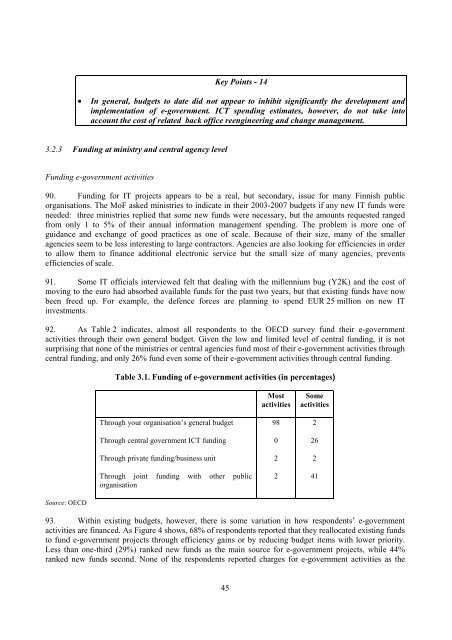e-GOVERNMENT IN FINLAND - ePractice.eu
e-GOVERNMENT IN FINLAND - ePractice.eu
e-GOVERNMENT IN FINLAND - ePractice.eu
Create successful ePaper yourself
Turn your PDF publications into a flip-book with our unique Google optimized e-Paper software.
Key Points - 14<br />
x In general, budgets to date did not appear to inhibit significantly the development and<br />
implementation of e-government. ICT spending estimates, however, do not take into<br />
account the cost of related back office reengineering and change management.<br />
3.2.3 Funding at ministry and central agency level<br />
Funding e-government activities<br />
90. Funding for IT projects appears to be a real, but secondary, issue for many Finnish public<br />
organisations. The MoF asked ministries to indicate in their 2003-2007 budgets if any new IT funds were<br />
needed: three ministries replied that some new funds were necessary, but the amounts requested ranged<br />
from only 1 to 5% of their annual information management spending. The problem is more one of<br />
guidance and exchange of good practices as one of scale. Because of their size, many of the smaller<br />
agencies seem to be less interesting to large contractors. Agencies are also looking for efficiencies in order<br />
to allow them to finance additional electronic service but the small size of many agencies, prevents<br />
efficiencies of scale.<br />
91. Some IT officials interviewed felt that dealing with the millennium bug (Y2K) and the cost of<br />
moving to the <strong>eu</strong>ro had absorbed available funds for the past two years, but that existing funds have now<br />
been freed up. For example, the defence forces are planning to spend EUR 25 million on new IT<br />
investments.<br />
92. As Table 2 indicates, almost all respondents to the OECD survey fund their e-government<br />
activities through their own general budget. Given the low and limited level of central funding, it is not<br />
surprising that none of the ministries or central agencies fund most of their e-government activities through<br />
central funding, and only 26% fund even some of their e-government activities through central funding.<br />
Source: OECD<br />
Table 3.1. Funding of e-government activities (in percentages)<br />
Through your organisation’s general budget<br />
Through central government ICT funding<br />
Through private funding/business unit<br />
Through joint funding with other public<br />
organisation<br />
45<br />
Most<br />
activities<br />
98<br />
0<br />
2<br />
2<br />
Some<br />
activities<br />
93. Within existing budgets, however, there is some variation in how respondents’ e-government<br />
activities are financed. As Figure 4 shows, 68% of respondents reported that they reallocated existing funds<br />
to fund e-government projects through efficiency gains or by reducing budget items with lower priority.<br />
Less than one-third (29%) ranked new funds as the main source for e-government projects, while 44%<br />
ranked new funds second. None of the respondents reported charges for e-government activities as the<br />
2<br />
26<br />
2<br />
41
















